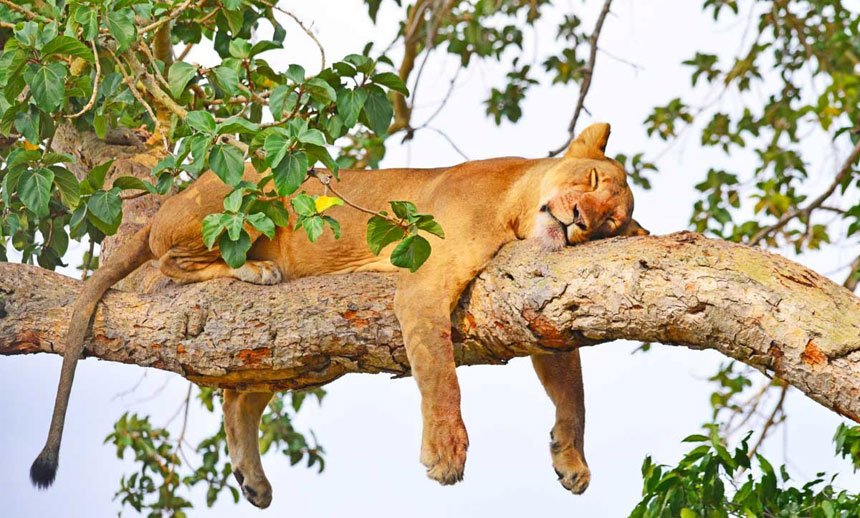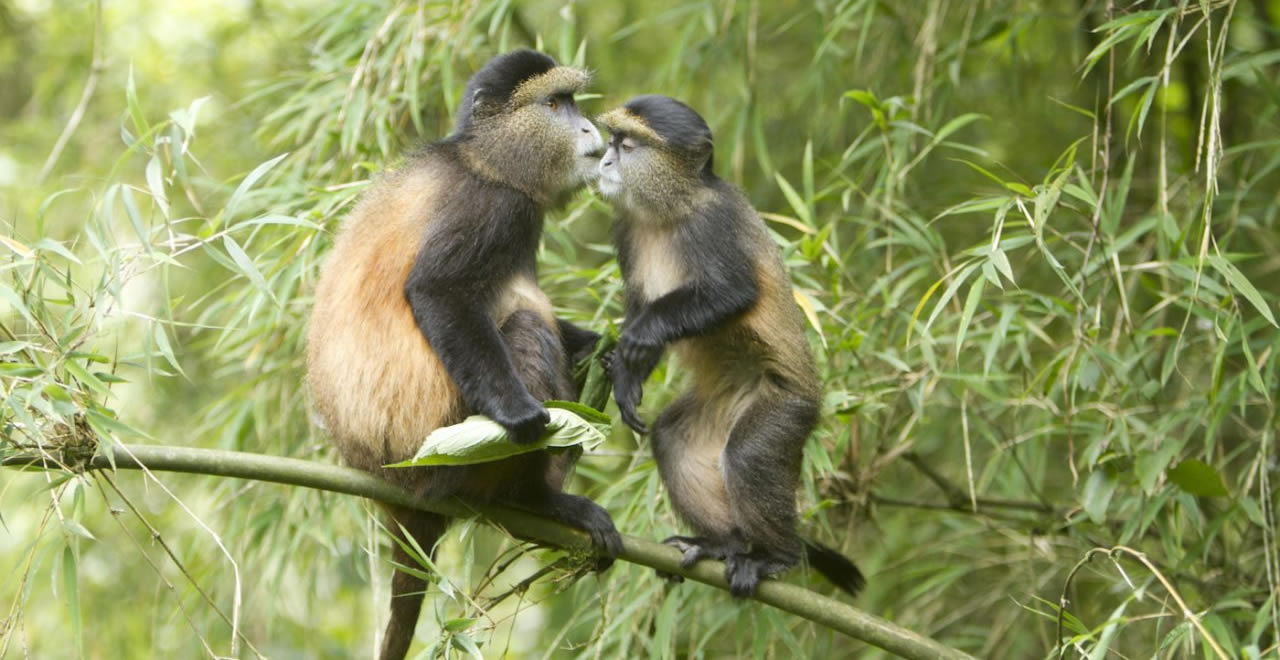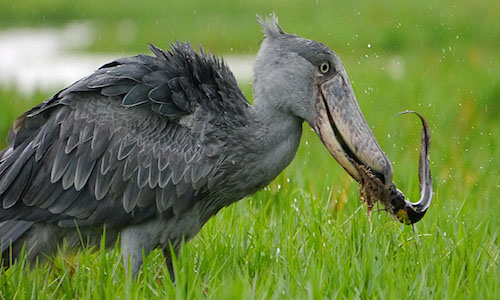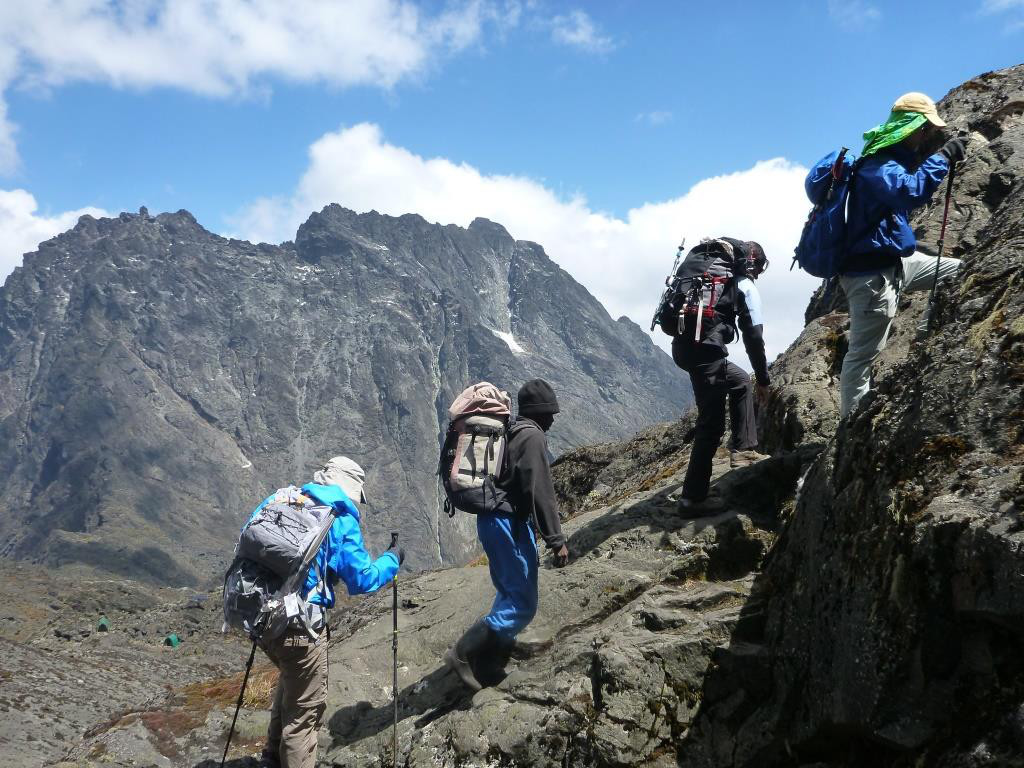One of the most important protected areas for biodiversity conservation in Rwanda, Nyungwe national park is located in Rusizi district Southern Province. The protected area covers 1,019 sq.km (633.7 sq. miles) and forms part of the Albertine Rift Valley. The park was gazetted in 2004 in order to protect a variety of wildlife in Nyungwe forest including 13 primate species.
According to the Rwanda Development Board (RDB), a part of Nyungwe known as Cyamudongo forest had been taken by encroachers. The local communities around the protected area contain one of the highest human population densities in Rwanda with about 1,000 people per square kilometer. As such, there was a lot of pressure exerted on the natural resources through hunting for bushmeat, firewood, charcoal, medicinal plants and water collection. In fact, forest elephants and Congo buffaloes were almost getting extinct from the park due to poaching. In order to strengthen the management of Nyungwe forest, RDB entered into a long-term partnership with the African Parks Network (APN) in 2020 to enhance conservation, protection of the park and benefit the adjacent communities. Through environmental clubs, over 6,000 members and 1,000 children are now actively involved in park management.
Vegetation in the park
Nyungwe is an afro-montane tropical forest with altitude ranging from 1,600m to 2,950m above sea level. Due to varying altitude, there are several vegetation types including bamboo on the medium altitude (1,800m), open papyrus swamps and grasslands at lower altitudes. Much of the habitat is a dense forest with trees and shrubs intertwined together. The forest contains 1,068 plant species of which 137 are Albertine rift endemics according to the African Parks database. There are endangered hardwood tree species such as brown Mahogany and Entandrophragma which can grow up to 45 meters tall. Gastrodia rwandensis is a unique flowering plant endemic to Rwanda and doesn’t depend on photosynthesis, instead it feeds on fungus to grow.
Animals
One of the goals of the partnership is to turn Nyungwe forest into a sustainable tourism destination. The park contains rich biodiversity with 13 primate species including chimpanzees and endangered monkey species. These include golden monkeys, Hamlyn’s monkeys, owl-faced monkeys, gray cheeked mangabeys (Cercocebus albigena johnstoni), L’hoest monkeys, and dwarf galago (Galago demidoff). Others include blue monkeys (cercopithecus mitis doggetti), red-tailed monkeys, velvet monkeys and olive baboons.
The forest is also famous for harboring the largest population of black and white colobus monkeys, with a troop of over 400 black and white colobus monkeys habituated for tourism. Nyungwe forest is also home to 322 bird species of which over 16 are Albertine Rift Endemics (AREs) such as stripe breasted, red faced woodland warbler, Dohote’s Bushrike, Rwenzori turaco and the purple sunbird. Those intending to see primates in the wild, Nyungwe is one of East Africa’s best destinations and worthy to be on your Rwanda safari bucket list. Chimpanzees, colobus monkeys are the most sought-after primates that have been habituated for tourism. The park is also home to 75 mammal species including leopards, giant forest hogs, porcupines, tree hyrax, two spotted palm civets, giant forest, mountain sun and lord derby’s flyinmg squirrels, slender and marsh mongoose, and black fronted duikers. Spotting these mammals in Nyungwe is difficult, but chances are higher for those intending to hike into the deeper parts of the forest.
Tourist activities in Nyungwe national park
Upon visiting Nyungwe national park, there are several experiences to enjoy, including canopy walk, chimpanzee trekking, colobus monkey tracking, hiking and bird watching. The local communities adjacent to the park offer camping, tea and coffee experiences. Visitors are not permitted to explore the park on their own but must have a RDB recommended tour guide. However, driving on the main through the park is acceptable and takes 1.5 hours to cross from one end to the other. Booking for activities in Nyungwe is available through the Rwanda Development Board online web portal – Irembo or through a trusted tour operator. All activities in the park start at any of the 3 visitor information centers, visitors need to know in advance where exactly to be on time. For primate trekking, children under 16 years aren’t allowed to participate, but can take part in all other activities.
Chimpanzee trekking
Cyamudongo is a montane forest at a lower elevation between 1,700 and 2,100 meters above sea level. The forest stretches across 5 hills surrounding the Nyamabuye river valley and contains rich biodiversity including a large community of over 600 chimpanzees and birds. The forest is famous for harboring flora and fauna species endemic to Rwanda only such as Polystachya bruechertiae, Boulengerula fischeri (amphibian) and Gastrodia rwandensis a flowering plant that doesn’t depend on photosynthesis instead it feeds on fungus to grow.
Tracking chimpanzees in Nyungwe forest national park is conducted in Cyamudongo forest, an isolated forest that was incorporated as part of the protected area in 2004. Visitors must be aware of the starting point and stay closer to it in order to report there on time. Chimp trekking can begin either at Uwinka or Kitabi centers, therefore communication with your guide or park authorities is important in order to go to the right place. Tracking begins early in the morning between 7:00 am to 7:30 am, RDB guides will conduct a briefing on what to expect. Ensure to report there with the right gears and packing for chimpanzee tracking should include hiking boats, long trousers, insect repellant, camera and extra batteries, packed lunch and drinking water. Hiking can be challenging due to the nature of terrain, therefore maximum preparation is key to successful tracking. Finding the chimps might take 2 – 5 hours. Porters are available for hire at extra cost and will help carry your luggage as well as extend a hand whilst hiking.
Colobus monkey tracking
Nyungwe forest boasts East Africa’s largest troop of black and white colobus monkeys with over 400 individuals. The colobus monkeys have been observed foraging together of which most have been habituated, making it easier for visitors to see the primates in their natural habitat. Colobus monkey tracking in Nyuwe forest national park starts at Uwinka and Gisakura visitor centers. At Uwinka, the activity is available in the morning with the first session starting at 7 am and another at 11 am. Tracking at Gisakura visitor information center occurs in several sessions from 8 am, 11am, 1pm to 3 pm. Booking for colobus monkey tracking should be done in advance.
Mangabey monkey tracking
Mangabeys belong to the old-world monkeys and are an endangered species endemic to Africa.There are two subspecies of mangabeys differing by physical features including the crested and white-eyelid mangabeys. However, all species have a tail longer than their bodies. Nyungwe forest in particular has a considerable population of Gray cheeked mangabeys. Locally known as ‘the ones with thin waists’, they’re recognized by their calls which can be heard at a distance of 1km. This makes them easy to identify, however, when they’re calling each other, they can be found living in troops of 10 to 40 individuals. Tracking the mangabeys in Nyungwe is available at Uwinka visitor center starting at 9:00am, booking earlier is recommended.
Canopy walk
The Nyungwe forest canopy walk is 160 meters long, which is equivalent to a football pitch and half. Probably the longest in Africa, the canopy walkway is suspended 90m, 45m and 25 m above the ground. Visitors can select a part based on their comfort level with heights. Given that the walkways are opaque and not threatening, kids of all ages can do the canopy tour. Starting at 8 am, 10 am, 1pm, and 3 p.m., visitors need to arrive at the Uwinka visitor center ahead of time for a briefing. Going to the canopy walkways includes hiking along the Igishigishigi trail (2.4 km) which takes 1.5 hours before reaching and the canopy walk itself lasts 2 hours.
Hiking
There are 22 hiking trails in Nyungwe forest national park that lead to scenic areas, places to look for birds, waterfalls as well as to the tea plantations in the local communities. There are 11 trails that begin from the Uwinka visitor center including Kamiranzovu waterfalls hike, canopy walk and colobus monkey tracking. Imbaraga trail has 4 waterfalls to see, Isumo trail that takes you to the Gisakura tea plantation while huge tree species and medicinal plant species can be found along the Umuyove Trail. Hiking trails can also be found at Gisakura and Kitabi Centers. Information concerning the range, distance and time can be obtained from there.
Attractions in Nyungwe national park
Kamiranzovu waterfalls
A beautiful spot for keen photographers, Kamiranzovu waterfalls are 50 meters long and the most spectacular in Nyungwe national park. The falls are divided into two sections, with the first having waters falling on rocks and a second side in front of the flowing water. The 10 km round trip lasts 6 hours and offers visitors to walk through the interior part of the forest to a large swamp, which is the source of the falls. Visitors must be accompanied by a guide and should carry packed lunch, drinking water, rain jacket, hiking stick. The trail can be challenging due to the nature of terrain and it can rain anytime of the day. Throughout the hike, the guides talk about the flora and fauna and you might spot primates and birds.
Mount Bigugu
Mount Bigugu, 2,950 m above sea level (9,583 feet) is the highest mountain in Nyungwe forest national park and south-west Rwanda. RDB has created trails giving visitors access to the summit. The elevation gained hiking along the 7 km long nature trail is 666m. This can be rated as a medium to difficult hike but worth it due to birding opportunities and spectacular views at the summit. There are several species you might spot including the Albertine rift endemics such as the red-faced woodland warbler and the stripe breasted tit.
Banda village experience
Banda provides the chance to interact with residents, learn about their lifestyles, and see how they are involved in conservation through their arts and crafts. There are over 6,000 people living in the Banda village of which most rely on natural resources and engage in sustainable farming. Tourism has been helping these people to cope with challenges such as providing access to clean water, energy saving stoves and empowering arts and crafts experiences since through the revenue sharing scheme. As a result, Banda is now a model for sustainable development, with opportunities to take part in Rwandan traditional dances, basket weaving, banana beer brewing activity and volunteering with the community health care among other projects.
Accommodation in and around Nyungwe national park
When it comes to accommodation, there is a variety of options to consider;
Tree House
The Nyungwe tree house is part of the award winning One & Only luxury resorts and private homes. Enjoy first class food and facilities including a swimming pool and SPA. The lodge is designed to accommodate individuals, families and couples with 5 wooden tree-top level villas and 22 luxury rooms built on the edge of the primary forest overlooking the Gisakura tea plantation near the eastern entrance gate. Visitors can enjoy unparalleled views and sounds of the jungle.
Katabi Eco-tourism center
The Katabi Eco-tourism center offers a mid range option as well as a camping ground where you can pitch your own tent. Accommodation is provided in traditional huts giving you a Rwandan cultural experience. Although the rooms are comfortable, there are no bathrooms within, so you will need to leave the room to relieve yourself. Getting outside at night is secure since the cottages are inside a fortified palace that is guarded by security personnel. The lodge enhances the local community conservation and employs many people including ex-poachers. Their Kitchen and restaurant offers locally grown food, the daily menu contains Rwandan cuisine as well as international dishes including Pizza. Soft drinks and beers are also available.
Camping in Nyungwe forest
Nyungwe forest camping sites are available at Uwinka visitor information center and next to the canopy walk along the Igishigishigi trail. There are basic toilet facilities and raised wooden platforms, making it a safe place for camping in the jungle. Those intending to have Nyungwe forest camping experience should consult RDC or tour operator. Food and drinks can be obtained at the Uwinka visitor center Canteen.
How to get there
Situated in Southern Province, Nyungwe national park is 218.3 km (5-hour drive) south-west of Kigali capital city and 201 km (4-hour drive) south of Gisenyi resort town. The park has three Rwanda Development Board (RDB) offices including Uwinka in the center, Gisakura on the western side and the Katabi Eco-tourism center on the eastern side of the park. Both are connected by a tarmac road that passes through the forest. Booking is available only at Uwinka, which is the main visitor center of the park. However, visitors are advised to book activities such as chimpanzee trekking in advance through an online Irembo government website, and tour operators
The closest town, Rusizi town (formerly Cyangugu), is 57 km (one hour’s drive) from the eastern entrance gate. The park can also be reached by air through Kamembe airport (KME), just 3 km north of the town and 57 km (1-hour 30 min drive). Helicopter flights to Nyungwe forest take 45 minutes only and are available only through Akagera, the only company conducting Rwanda flying in safaris to all national parks.





